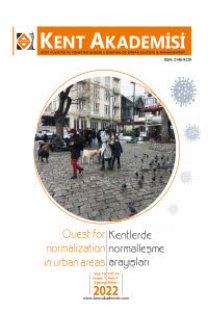Yaşayan Dünya Mirası Geleneksel Kent Dokusunun Oluşumu (İran-Tebriz’in Tarihi Kapalı Çarşı Kompleksi)
Geleneksel Kent Dokusu, Fiziksel - Sosyal Kimlik, Dünya Mirası, Tebriz’in Tarihi Çarşı Kompleksi
The Formation of Living World Heritage Traditional Urban Pattern (Case Study: Iran-Tabriz Grand Bazaar Complex)
Traditional Urban Pattern, Physical - Social Identity, World Heritage, Tabriz Historic Bazaar Complex,
___
- Beg Munshi, E.(2003). Tarikh-e Alamara-ye Abbasi, Corrected byIraj Afshar. Tehran, Amir Kabir Publications, p.256.
- Chelebi, Evliya, (1959). Seyahatname Evliya Çalabi, Corrected by Hossein Nakhjavani. Tabriz, Shafaq Publication, P.16.
- Dehkhodā, A. A., (1993). Persian Dictionary, 13th Volume, Tehran, Tehran University Press, P. 19404.
- Dumont, P. and Georgeon F., (1999). The Ottoman Cities During the Modernization Process. 2nd Edition, Translated by: A. Berktay. İstanbul: History Foundation Domestic Publications.
- Faroqhi, S., (2000). The Cities and City People in the Ottoman. İstanbul: History Foundation Domestic Publications.
- Flanden, Eugene (1977). Eugene Flandin's travelogue, translated by Noor Sadeghi, Ishraqi Publications, Tehran, pp. 83-67.
- Gabriel, A., (1928). Etapesd’uneCampagnedans les deuxIrakd’apre sun manuscript Turc du XVIeslecle in: Syria Tome9. Fascicule, (4), pp. 53-55.
- Gharipour, M., (2012). The Bazaars in Islamic City: Design, Culture and History. The American University in Cairo Press, Cairo.
- Guichard, P., (1997). Suk, in the Muslim West. Encyclopedia of Islam, Ed., Bosworth, C.E., Vandonzel, E., W.P. Heinrichs, W.P., G. Legomte, 4, pp. 789-791.
- Habibi, L., Mahmoudi Pati F., (2017).From Bazaar to Shopping Centers: Analysis of the Evolution of Modern Commercial Spaces in Tehran, The Scientific Journal of NAZAR research center (Nrc) for Art, Architecture & Urbanism, vol.14/No.49, Tehran, p. 15.
- Haghparast F., Esmaeili Sangari H. (2018). Manage the World Heritage Sites in Tabriz, relying on popular participation, Urban Management Journal, No.50, Spring, pp. 145-162.
- Hashri Tabrizi B., Molla Mohammad A., (1992). Rozat-al Athar (1011 AH), Corrected by Aziz Dolatabadi. Tabriz: Sutudeh Publications, p. 256.
- Hasol, D., (1975). EncyclopedicDictionary of Architecture, Advanced 13th Edition, İstanbul: YEM Publication, 2014.
- Hojbar Nobari, A., (1999). Report of archaeological excavations around the Blue Mosque, Tabriz Cultural Heritage Archive, p. 6.
- İbrahimgil, A., (2018). Traditional Urban Pattern Investigation and Protection Proposal in Skopje, Macedonia. Ph. D. Thesis, Ankara: Gazi University, p. 116.
- İnalcık, H., (1997). The Pearl of İstanbul: Bedesten Mustafa Özel (prep.), Economics and Religion. İstanbul: İz Publication, pp. 119–136.
- Kejanlı, D., (2010). Anadolu’da Selçuklu ve Osmanlı Dönemlerinde Kent Sistemi, Kale ve Merkez-Çarşı gelişimi, E-Journal of New World Sciences Academy, 5 (3), pp. 287-303.
- Kuban, D., (1968). Some Observations on the Anatolian-Turkish City, its Development and Social and Physical Characteristics, Foundations Journal, no. 7, pp. 53–73, İstanbul.
- Kubat, A.S., (2010). The study of urban form in Turkey. Sixteenth International Seminar on Urban Form, Guangzhou, China, 4 -7 September 2009. Urban Morphology (2010) 14(1), pp. 31-48.
- Minorsky, V., (1958). History of Tabriz, translated by Abdul Ali Karang, Tabriz, p. 34.
- Omrani, B.,Esmaeeli, H., (2006). Bafte Tarikhi-ye Shahre Tabriz, Tehran, Samira Publications, p. 68.
- Özdeş, G., (1998). The Turkish Markets. Ankara: Tepe Publication, p. 265.
- Tehrani, F., Parsi, F., and Banimasood, A., (2007). Reading the historical maps of Tabriz.Tehran: Iran Urban Development and Improvement Company.
- Zoka, Y., (1989). Tabriz in the cities of Iran, by the efforts of Mohammad Yousef Kiani, vol.3, Jahad University, Tehran, p. 154-162.
- Url.1: http://www.css.ir/en
- Url. 2: https://www.tasnimnews.com/fa/news/1398
- Url. 3: https://akharinkhabar.ir/photo/5187130/1398
- ISSN: 2146-9229
- Yayın Aralığı: Yılda 4 Sayı
- Başlangıç: 2008
- Yayıncı: Karadeniz Yazarlar ve Şairler Derneği
Toplu Taşıma Araçları Sefer Sıklığı Belirleme ve Çizelgeleme Problemi
Sahra BAŞYAZGAN, Mustafa Sinan YARDIM
Sanatsal Bir İfade Aracı Olarak Cam Malzemenin Anlatım Olanakları
Çelik Cüruflarının Potansiyel Kullanım Alanlarının Değerlendirilmesi
Gülşen TOZSİN, Burak KAVASOĞLU
Mehmet İlkan BAYRAK, Alper SAĞLIK
Ekoturizm'in Türkiye ve Dünyadaki Gelişimi
Sultan Ece ALTINOK ÇALIŞKAN, Osman UZUN
Kırsaldan Kente Miras Endüstri Arkeolojisine İki Örnek: Isparta Bıtrak ve Hüseyin Baş Değirmenleri
Ayşe Betül GÖKARSLAN, Duygu KÖSE
Tarihi Dokuda Kentsel Aydınlatma Tasarımı: Adana-Kayalıbağ Mahallesi
Yeşil Altyapıların Önemli Bir Parçası Olarak Avlu Peyzaj Tasarım Süreci
Geçmişten Geleceğe: İstanbul’da Kent ve Orman Ekolojiisinin Ayak İzi
